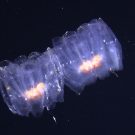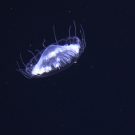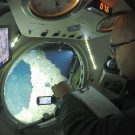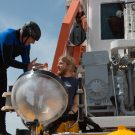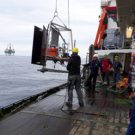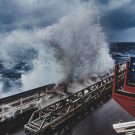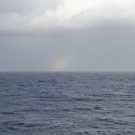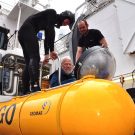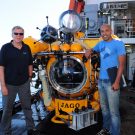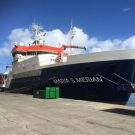english version below Die biologische Ozeanographin Helena Hauss und die Ozeanographie-Studentin Anna-Christina Hans erzählen hier von ihrer spannenden Forschung an Strömungswirbeln im Östlichen Atlantik Eines der Ziele unserer Forschungsreise ist, die Rolle von Wirbeln (oder „Eddies“) für das pelagische Ökosystem der Kapverden besser zu verstehen. Wirbel sind rotierende Wasserkörper im Ozean von meist etwa fünfzig […]
POS532: Tracing elusive deep-sea squid using environmental DNA
[deutsche Version unten] by Stella Scheer and Veronique Merten The PhD students Stella Scheer and Veronique Merten of the Deep-Sea Biology Working Group at GEOMAR are reporting here about a method to trace marine animals without observing the animals During our cruise we sampled five different locations for environmental DNA (eDNA), including in- and offshore […]
POS532: First observations on deep water benthic communities in Cabo Verde coastal areas
(Deutsche Version unten) by Rui Freitas, 22-Feb-2019 Rui Freitas is a marine biologist and lecturer at the University of the Cape Verde. Here he reports about his two dives with the manned submersible JAGO down to the steep slopes of Santo Antão and Fogo. The deeper slopes of the Cape Verde islands have never been […]
POS532: JAGO-Pilot werden…/ To become a JAGO pilot
english version below …braucht Zeit und die richtigen Bedingungen! Hier erzählt JAGO-Pilot Peter Striewski von seinem Weg ins „JAGO-Cockpit“ Wer den eng getakteten Forschungsbetrieb auf Ausfahrten mit einem Forschungsschiff kennt, weiß, dass es gar nicht so einfach ist, Zeit zum Üben eines reibungslosen Einsatzes von mitgebrachten Geräten und – wie in unserem Fall – Fahrzeugen […]
Expedition POS527 ist unterwegs
Die Expedition POS527 mit dem Forschungsschiff POSEIDON zur Goldeneye Region in der Nordsee ist ein wichtiger Bestandteil des STEMM-CCS Projektes. Ausrüstung und Abreise Startpunkt für die Expedition war am 14. August 2018 in Kiel. Die Teilnehmerinnen und Teilnehmer reisten vom Plymouth Marine Laboratory (UK), vom National Oceanography Centre Southampton (UK), vom MPI Marine Microbiology (Bremen), […]
Week 1 aboard the RV SONNE (English)
Two months at sea. Fiji to Japan. No land, possibly a few far-off ships passing by, and 38 scientists, many of whom are known only to each other through their publications. This was the setting for the beginning of RV SONNE cruise SO264. The anonymity was quickly remedied as we boarded the vessel on June […]
From the Canary Islands to Crete: sailing the Mediterranean straits, Part II
Bottlenecks – part II (read part I here) In our final blog we will re-capture our journey through the Mediterranean as it is not very often that one gets to travel from one end almost to the other. The Mediterranean is unique because of its numerous passages and straits. These maritime bottlenecks also characterized our […]
POS520: Exciting Discoveries / Spannende Entdeckungen
Oceanographic pioneer Maurice Ewing is reported to have advised his students that the key to discovery is to take a new instrument to a place where no one has explored before. The midwater research conducted off the Cape Verde Islands during Poseidon Cruise 520 is a fine example of that research philosophy. The unique combination […]
POS520: My dive into the deep / Mein Tauchgang in das unendliche Blau
by Nuno Vieira (INDP) During POS520 I help my German colleagues to collect environmental data with a CTD and water sampler rosette. I filter seawater samples taken in different depths to determine its oxygen content, and I assist in operating the Microstructure Probe which is used to profile the vertical current structure of the ocean. […]
From the Canary Islands to Crete: sailing the Mediterranean straits, Part I
Bottlenecks In our final blog we will re-capture our journey through the Mediterranean as it is not very often that one gets to travel from one end almost to the other. The Mediterranean is unique because of its numerous passages and straits. These maritime bottlenecks also characterized our journey, but luckily mproved to be the […]
